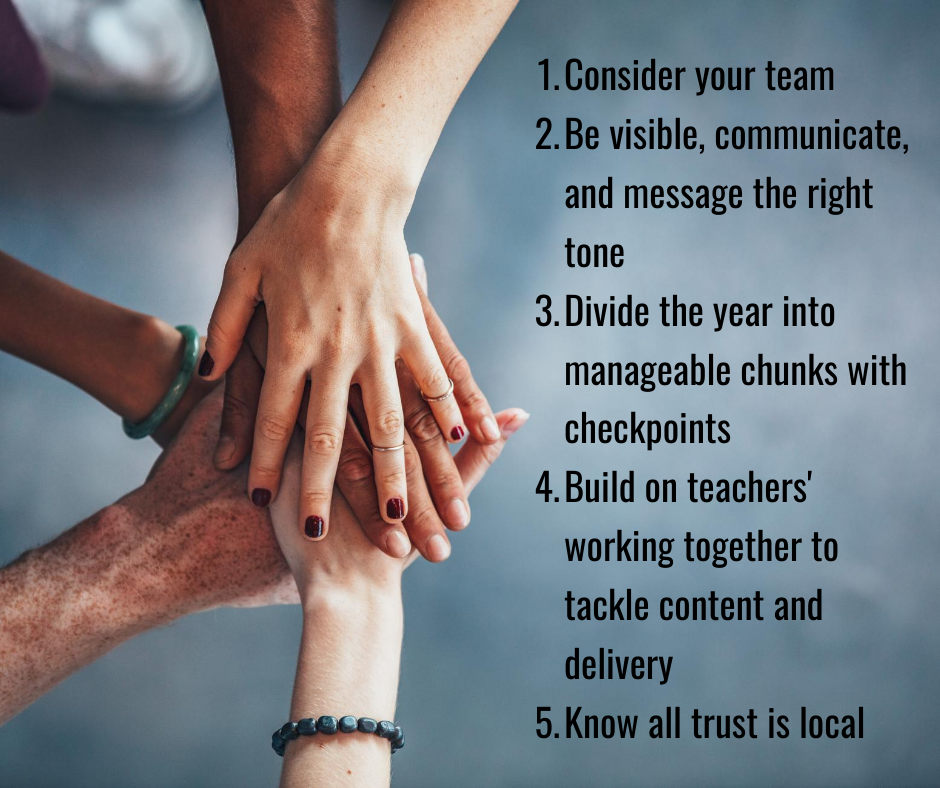Leading During the Pandemic
If there are any lessons we have learned during this pandemic, it is how empathy, strong relationships and a "can-do" attitude can allay concerns and calm anxieties. Effective leaders, though, do more than help others feel better. They learn, make decisions, instill hope, and grow personal agency into a collective force.
Five practices, adapted for the context facing our districts and schools, can serve as reminders:
- Consider your team - For working on this pandemic, team size and members may be different from those called on in the past. Members should know the "pulse" of the district/school, how to best gather information, make timely decisions, craft messages, anticipate rough patches, serve as ambassadors to key groups, and not be afraid to tell you both good and bad news. When leaders forge ahead (with little input), they travel a lonely road with missteps likely. When leaders hesitate too long in making decisions, resentment, confusion and loss of trust follows. Find the "sweet spot" for next steps and needed adjustments.
- Be visible, communicate, and message the right tone - Develop 2-3 overarching messages that become your "signature words" for all stakeholders (families, students, staff, community, etc.). Adapt for particular groups and remember to include support staff (cafeteria workers, custodians, bus drivers, etc.). Set a regular schedule for listeners to tune in "live" or later and include positive stories to show how the district/school is moving forward. Listen to worries and concerns that bubble up. Use local cable, radio, social and print media outlets to talk often with the community.
- Divide the year into manageable chunks with checkpoints - Much of the stress of this pandemic emanates from no foreseeable end in sight. Break down the journey into calendar zones to share updates. Be ready to pivot from the course and explain why. Admit mistakes and share the rationale for changes. Most people will accept and support their leaders when they are told "up front" what will take place and why. Clarity adds to credibility.
- Build on teachers' working together to tackle content and delivery - Expect vertical team meetings (between grades) to decide how to scaffold grade-level work for priority learning standards. Group teachers strategically for navigating technology and planning for inevitable school interruptions. Talk with families what in-person, remote-synchronous, remote-asynchronous, and hybrid learning models will look like for their children. Have staff, who can serve as engagement trackers, devise interventions once it is known why students may have fallen off the radar or are sporadically seen. Communicate (as the school/district leader) how you plan to show up "in classrooms" to see how kids are learning in this new normal.
- Know all trust is local - Things will continue to change. Everyone looks to their leader to help them get through this. As daunting as it seems, the leader who stays the course, sustains optimism, and validates efforts, will develop resilience in those they lead and serve as a tremendous force for good.

This pandemic will end, and people will look back at what leaders did during these unfathomable times. Many will not remember the details of a district or school plan nor the daily problems you solved to make it all work. They will remember how you listened, talked, answered questions, cheered them on, and, called up the competence and confidence they never thought they had to become better for the kids in front of them.